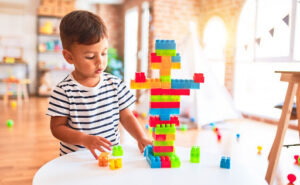The importance of play in language development
 Many parents are confused when their birth-to-three speech therapist arrives and begins talking about “play skills” instead of “speech skills.” Do not fret! Speech and play skills are HIGHLY related. Play, and more specifically pretend play, gives us a look into your child’s world. Play skills demonstrate your child’s cognitive skills, which are your child’s ability to think, process language, play attention, learn, and plan their next move. All of these skills are essential for speech and language development!
Many parents are confused when their birth-to-three speech therapist arrives and begins talking about “play skills” instead of “speech skills.” Do not fret! Speech and play skills are HIGHLY related. Play, and more specifically pretend play, gives us a look into your child’s world. Play skills demonstrate your child’s cognitive skills, which are your child’s ability to think, process language, play attention, learn, and plan their next move. All of these skills are essential for speech and language development!
Let’s break it down!
There are four basic types of play: Exploratory, Functional, Constructive, and Pretend.
Exploratory: using senses of touch, taste and smell to learn about new objects. This begins when your child has intentional control over their body. Children who enjoy shaking, mouthing or smelling new objects are in the exploratory stage.
Functional: using toys and objects as they were intended. Functional play, such as is using a spoon to stir, racing cars or rolling a ball. Pay attention to whether your child is using an object or simply enjoying watching one part of the object, such as wheels turning.
Constructive: manipulating objects to make something new. This stage of play includes more trial and error to see how pieces can work together with a final goal in mind. Constructive play includes building train tracks, assembling and disassembling blocks and other toys, or sorting shapes and objects.
Pretend or symbolic: using objects in imaginary ways. Such as, pretending your hand or a block is a phone, emptying a box to make a doll a bed or bathtub, pretending a baby is crying and soothing a baby, or making a pretend steering wheel for a car. Children who dress up and act like a specific person are also engaging in pretend play.
Why is it important?
If your child is using functional play then they are demonstrating an understanding of what objects are and why they are used. When your child uses pretend play, they are demonstrating symbolic understanding of one object for another object. Words are also symbolic! Words are a symbol to represent objects, people, events, feelings, and physical states. If your child is using objects for another object, then your child demonstrates understanding that words have symbolic meaning and the cognitive skills for using words meaningfully!
Children who are using words, but are not yet playing functionally or symbolically, likely do not yet have a solid understanding of word meanings and may have difficulty using the same words in a variety of contexts. For example, think of all the ways we can play with a ball: we can roll, throw, or bounce a ball. There are different balls for different sports, or we could even pretend a ball is an apple. A child who only knows “ball” for labeling or does not yet play with a ball meaningfully is not understanding what that toy is used for and how it can be related to other objects or people. Children who are not using pretend play by the time they are two years old are at risk of cognitive and speech and language deficits.
Ways to help your toddler!
Meet your little one where they are with play. If your child is still in the exploratory phase, try modeling constructive play (fill and dump or assemble and knock down) and functional play to begin showing how objects go together. For example, a spoon can be used for stirring or eating food, but we don’t use a spoon to wiggle in front of our face.
Once your little one has some early play skills, get creative and add additional prompts or a new way to play. Pretend food, animals and baby dolls are some of my favorite toys for pretend play!
For more information on pretend and symbolic play, check out a previous blog from Kim Shales, our director of developmental therapy.
If you have further questions or concerns, call PlayWorks Therapy, Inc. for a full speech and language evaluation.
Jessica Delos Reyes, MA, CCC-SLP
Speech-Language Pathologist
Image: https://www.google.com/search?q=pretend+play&source=lnms&tbm=isch&sa=X&ved=0ahUKEwirjJi9097WAhUi3YMKHdKuDyQQ_AUICygC&biw=1198&bih=700#imgrc=-kgdDwYHFdD1kM:




 Many parents are confused when their birth-to-three speech therapist arrives and begins talking about “play skills” instead of “speech skills.” Do not fret! Speech and play skills are HIGHLY related. Play, and more specifically pretend play, gives us a look into your child’s world. Play skills demonstrate your child’s cognitive skills, which are your child’s ability to think, process language, play attention, learn, and plan their next move. All of these skills are essential for speech and language development!
Many parents are confused when their birth-to-three speech therapist arrives and begins talking about “play skills” instead of “speech skills.” Do not fret! Speech and play skills are HIGHLY related. Play, and more specifically pretend play, gives us a look into your child’s world. Play skills demonstrate your child’s cognitive skills, which are your child’s ability to think, process language, play attention, learn, and plan their next move. All of these skills are essential for speech and language development!